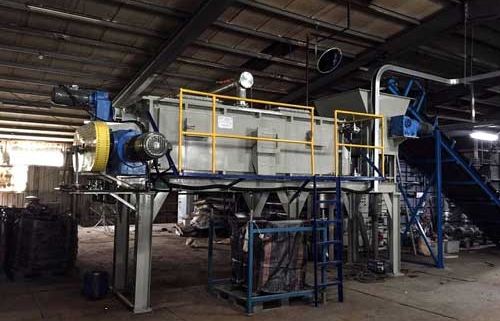After being dried by sludge dryer, the sludge can be used in coal-fired power plants, cement plants, garbage treatment plants and other factories to replace traditional fuels. It is important that sludge can reduce waste emissions and protect the environment. Etc. The benefits of sludge drying are no longer illustrated. As we all know, different types of sludge dryers (sludge dryer specific type information: sludge dryer classification Daquan) can dry different types of sludge, of course, the dryer requirements for sludge are not the same, specifically What are the requirements?
Drying equipment requirements for different types of sludge
1. Domestic sludge
In urban construction, the organic matter content of domestic sludge is high, generally up to 30-60%, and the water content is high, usually up to 95%-99%. Even after dehydration, there is still 60%-80% of water. At the same time, the domestic sludge contains a large number of pathogenic bacteria and parasites, which are prone to rot and stink, spread bacteria and affect people’s health. The sludge dryer can meet the characteristics of this sludge and can receive good social benefits through sterilization, drying and other processes.
Sludge dryer requirements for domestic sludge: The industrial production enterprise is required to install a complete sludge dryer. After the plate is pressed, the sludge with a moisture content of 80% is put into the material truck, and one material truck. Generally, it can carry sludge of between 300 and 500, and the sludge of the whole vehicle is sent to the drying room, and then the door is closed for drying. Start the setting parameters, run in three stages in time, and finish drying in twenty-four hours.
2. Printing and dyeing sludge
The printing and dyeing sludge accounts for 0.3-1% of the total sludge volume. It is similar to domestic sludge, has high water content, is not easy to dehydrate, and has large volume and quality. Since printing and dyeing sludge generally has a high inert substance, and the content of organic matter, pathogenic bacteria and the like is small, the calorific value is also low, and the content of heavy metals is generally high.
The requirements of the dryer for printing and dyeing sludge: The printing and dyeing sludge with a water content of about 80% is pretreated in the yard. This process not only allows a part of the water in the sludge to evaporate naturally, but also homogenizes the sludge. The pretreatment time can be determined according to the size of the stacking site and the weather conditions; in order to make the sludge fully contact with heat when it is dry, improve the efficiency of sludge drying, and at the same time create conditions for sludge granulation, it will pass The pre-treated printing and dyeing sludge is uniformly distributed into a drying device through a special feeding device to perform a drying process.
The sludge coming out from a drying device is sent to the second drying device through the screw conveyor for the second stage of drying; after the two-stage drying process, the sludge is continuously continuous with the rotation of the special drying device. Under the rolling, it is effectively dried, further granulated and ground, and gradually hardened. The sludge particles from the second drying device pass through the split sieve to use the sludge agglomerates with a particle size of 2-6 mm for firing lightweight energy-saving bricks and producing cement compacts, and the particle size is greater than or less than 2 The 6mm sludge agglomerate is used as an auxiliary fuel for coal combustion or as a landfill for landfill.
3. Paper sludge
The ash content of paper sludge is relatively large, generally can reach 50-70%, the hot land and water content are higher, generally reach 95-99%, the water content after dewatering can be as high as 70-80%, and the sludge volume is relatively large. And contains a lot of fiber. After the sludge dryer is dried, it can realize the comprehensive utilization of resources.
The requirements of the dryer for paper sludge: The paper sludge needs to be treated by the sludge concentration tank. Sludge concentration is a process of increasing sludge concentration by gravity sedimentation. After the sludge concentration is increased, the utilization rate of flocculant will be correspondingly increased, but the sludge concentration should be prevented from being too high, resulting in blockage of the pipeline for sludge transportation. Before entering the mechanical dewatering, the sludge needs to be added with flocculant for chemical conditioning, so that the sludge forms better flocs.
4. Electroplating sludge
The treatment of wastewater by electroplating is the main reason for the production of sludge. The content of organic matter in the electroplating sludge is small and the calorific value is small, and it contains many heavy metals.
Drying machine requirements for electroplating sludge: sludge containing 80%-90% moisture content is dried, the moisture content of the sludge after drying is 20%-30%, and the calorific value per ton of dry sludge after treatment It can reach 1200-2000 cards (equivalent to coal 220KG-480KG), can be mixed with coal and enter the boiler for common combustion, completely solve the troubles of sludge collection and landfill.
5. Tannery sludge
The production of tannery sludge is large, and in general, 40-80 tons of sludge can be produced every day. The organic matter content in the tannery sludge is high because a large amount of fur is generated during the leather treatment process, the content of the organic matter is very high, and there are many toxic substances.
Dryer requirements for tannery sludge: Typically, sludge contains 80% to 90% water. Working at temperatures above 650 ° C, the sludge dryer can reduce the moisture content to 10%-20%. In addition, the equipment can be applied to sludge drying in paper mills, chemical, electroplating, tanning, printing and dyeing industries, and has a wide range of applications.
6. Petrochemical sludge
In industrial production, petrochemical sludge is complex in composition and contains different types of heavy metals. Generally, petrochemical sludge contains oil, has high viscosity, high water content, small organic matter content and low calorific value.
Drying equipment requirements for petrochemical sludge: Most of the oil-containing sludge in the grease trap bottom sludge, scum, etc., enters the coking unit to replace the cold coke water of the coking tower, and at the same time recovers the oil. The remaining activated sludge and part of the oily sludge produced by the biochemical process are mixed and dried by a thin layer drying method. After drying, the materials are sent to the boiler for incineration, thereby realizing all the harmless treatment of the sludge.



